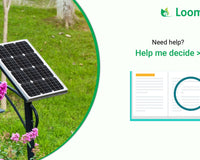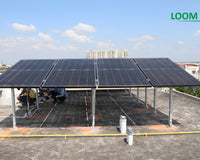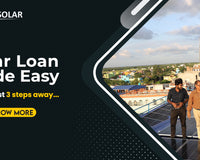An increasing demand of electricity day on day, people are planning to install rooftop solar in their homes to save electricity bill, but at this stage, the cost of solar system installation is slightly on the higher side that’s why they are showing interest, but waiting for government financial support. MNRE starts providing subsidy on rooftop solar panel installation for residential consumers. But, the main problem was how to apply subsidy for solar? Recently, MNRE introduces National Portal for Rooftop Solar where a consumer can apply rooftop solar themselves. In this blog, you will get to know benchmark cost of rooftop solar, how to apply for subsidy, components, quality and maintenance. Let’s continue reading…
How much cost of rooftop solar through subsidy scheme?
The CFA/subsidy will be available only for applications registered till 31.12.2022 in the National Portal and will be released after clearance by inspecting authority (DISCOM) on successful commissioning and installation of metering system as per specified procedure. The CFA/subsidy will not be applicable with retrospective effect.
Calculation of CFA/subsidy: The CFA/subsidy would be calculated on the basis of total solar module capacity/solar inverter capacity/capacity approved by DISCOM, whichever is lower.
Illustration for calculation of central Government subsidy
| Capacity | System Cost | Central Subsidy | Net Price |
| 2kW | ₹1,20,000 | ₹60,000 | ₹60,000 |
| 3kW | ₹1,80,000 | ₹78,000 | ₹1,02,000 |
| 5kW | ₹2,90,000 | ₹78,000 | ₹2,12,000 |
| 6kW | ₹3,48,000 | ₹78,000 | ₹2,70,000 |
| 8kW | ₹4,40,000 | ₹78,000 | ₹3,62,000 |
| 9kW | ₹4,95,000 | ₹78,000 | ₹4,17,000 |
| 10kW | ₹5,50,000 | ₹78,000 | ₹4,72,000 |
What are the major components and their standard / specifications of rooftop solar?
The below bill of material represents the package of rooftop solar to be offered to the consumer. For relevant specifications, refer to help document section.
| Si. No. | Materials | Standard / Specification |
| 1 | Solar Panel | As per MNRE specification/standards and registered in ALMM |
| 2 | On Grid Solar Inverter | As per MNRE/BIS Standard regulations |
| 3 | Module Mounting Structure (MMS) | Galvanized as per applicable IS |
| 4 | Structure Accessories | Stainless Stell 304 |
| 5 | Net Meter and Solar meter | As per DISCOM requirements |
| 6 | Array Junction Box | Projection as per Inverter requirement |
| 7 | AC Distribution Board | Protection as per Inverter & DISCOM/Grid requirement |
| 8 | Solar DC Cables & AC Cables | Total 50 metre in length and as per MNRE specifications |
| 9 | Earthing | As per MNRE specifications |
| 10 | Lighting Arrester | MNRE specifications |
| 11 | Earthing Cable / Strip | MNRE specifications |
| 12 | Connectors, Conduit pipes etc | MNRE specifications |
| 13 | Accessories | As per requierement |
| 14 | Other items required to complete project | As per requierement |
| 15 | Installation Testing and Commissioning | As per safety norms of SERC and CEA |
| 16 | Civil materials | As per MNRE specifications |
| 17 | Civil Work | As per MNRE specifications |
| 18 | Performance Testing | Minimum 75% |
| 19 | O&M and Warranty | 5 Years from the date of commissioning |
How to Apply for Rooftop Solar Installation on National Rooftop Portal in 10 Easy Steps?

The entire process has been explained in the following steps.
Step-1: Download SANDES app and register on the National Portal by selecting the local Distribution Company or Electricity department, as the case may be, referred as DISCOM, and enter Electricity connection number / Consumer number (mentioned in electricity bill), email id and mobile number. The registration process involves OTP authentication of mobile number and activation through email id. While sending activation link on email, the entire procedure will also be communicated to the applicant.
Step-2: After successful registration the applicant can proceed for submitting application for installation of grid connected rooftop solar system at residential house. The information already entered at the time of registration will be prefilled in the application form and the applicant will have to enter details such as, name on electricity bill, address, capacity of proposed rooftop solar system and details of existing rooftop solar system capacity installed, if any. The applicant also has to upload copy of latest electricity bill. On submission of application, the applicant will get a copy of application on email and it can also be downloaded after login to the portal.
Step-3: Application will be forwarded to the DISCOM for technical feasibility approval as per prevailing regulations. The applicant is advised to initiate installation of the rooftop solar system only after getting the feasibility approval from DISCOM. The technical feasibility approval or rejection, as the case may be, will be informed to the applicant through email.
Step-4: On receipt of feasibility approval from DISCOM, the applicant can proceed to install rooftop solar system. It is mandatory to get the rooftop solar system installed from any of the vendor registered/empanelled with DISCOM. Ministry has specified minimum technical specifications and standards for rooftops solar systems, which are to be followed. The applicant will have the option to choose equipment of higher quality/efficiency. The domestically manufactured solar modules using domestically manufactured solar cells listed in the ALMM should only be used by the applicant. In addition, the inverter should also be BIS certified. In order to protect the interest of the applicant an agreement to be signed between applicant and the vendor and a model format of the agreement is available on National Portal under Help Document section. It is mandatory for the vendor to provide comprehensive maintenance of the rooftop solar plant installed by the firm for at least 5 years.
Step-5: On completion of installation of rooftop solar system, the applicant has to submit project completion details for net-metering and approval (The project completion details will include wattage, make and numbers of solar modules, make and wattage of inverter, name of vendor that has installed the system, uploading of photograph of system, etc). Applicant also has to apply for net-metering. The net-metering application will forwarded to DISCOM and applicant has to follow instructions of DISCOM regarding payment of net-metering charges, signing of net-metering agreement, etc., as applicable.
Step-6: DISCOM officials will install the net-meter and inspect the system for fulfilment of minimum technical specifications and standards.
Step-7: Upon successful inspection and installation of net-meter, commissioning certificate would be generated online by DISCOM.
Step-8: Applicant has to submit bank details and upload copy of cancelled cheque. The fund handling agency will release the central Government subsidy directly into the bank account. The details of central Government subsidy available under simplified procedure may be checked on the National Portal.

Note: The applicant shall also check various informative material placed at Help Document section of the portal for better understanding of the procedure.
Operation and Maintenance Guidelines of Grid Connected PV Plants
1. For the optimal operation of a PV plant, maintenance must be carried out on a regular basis.
2. All the components should be kept clean. It should be ensured that all the components are fastened well at their due place.
3. During mandatory O&M period of 5 years, the rooftop solar PV plant has to be maintained by the vendor for the activity assigned to electrician/technician. The user shall be suitably guided by the vendor for all tasks lying in scope of the user and the user shall also be provided with appropriate documents for such guidance. Maintenance guidelines for various components viz. solar panels, inverter, wiring etc. are discussed below:
1. SOLAR PANELS
Although the cleaning frequency for the panels will vary from site to site depending on soiling, it is recommended that
i. The panels are cleaned at least once every fifteen days.
ii. Any bird droppings or spots should be cleaned immediately.
iii. Use water and a soft sponge or cloth for cleaning.
iv. Do not use detergent or any abrasive material for panel cleaning.
v. Iso-propyl alcohol may be used to remove oil or grease stains.
vi. Do not spray water on the panel if the panel glass is cracked or the back side is perforated.
vii. Wipe water from module as soon as possible.
viii. Use proper safety belts while cleaning modules at inclined roofs etc.
ix. The modules should not be cleaned when they are excessively hot. Early morning is particularly good time for module cleaning.
x. Check if there are any shade problems due to vegetation or new building. If there are, make arrangements for removing the vegetation or moving the panels to a shade-free place.
xi. Ensure that the module terminal connections are not exposed while cleaning; this poses a risk of electric shock.
xii. Never use panels for any unintended use, e. g. drying clothes, chips etc.
xiii. Ensure that monkeys or other animals do not damage the panels.
2. INVERTER
i. The inverter should be installed in a clean, dry, and ventilated area which is separated from, and not directly above, the battery bank (if applicable).
ii. Remove any excess dust in heat sinks and ventilations. This should only be done with a dry cloth or brush.
iii. Check that vermin have not infested the inverter. Typical signs of this include iv. Spider webs on ventilation grills or wasps’ nests in heat sinks. v. Check functionality, e.g. automatic disconnection upon loss of grid power supply, at least once a month.
vi. Verify the state of DC/AC surge arrestors, cable connections, and circuit breakers.
3. CABLES AND CONNECTION BOXES
i. Check the connections for corrosion and tightness.
ii. Check the connection box to make sure that the wires are tight, and the water seals are not damaged.
iii. There should be no vermin inside the box.
iv. Check the cable insulating sheath for cracks, breaks or burns. If the insulation is damaged, replace the wire
v. If the wire is outside the building, use wire with weather-resistant insulation.
vi. Make sure that the wire is clamped properly and that it should not rub against any sharp edges or corners.
vii. If some wire needs to be changed, make sure it is of proper rating and type.
4. SHUTTING DOWN THE SYSTEM
i. Disconnect system from all power sources in accordance with instructions for all other components used in the system.
ii. Completely cover system modules with an opaque material to prevent electricity from being generated while disconnecting conductors.
iii. To the extent possible, system shutdown will not be done during daytime or peak generation.
Other Useful Resources for Consumers, Installers and Manufacturers
1. How to Apply for Rooftop Solar Installation through Subsidy Scheme Application Process
2. Cost of solar system throgh subsidy scheme_CFA
3. Bill of Material Rooftop Solar
7. ALMM List
Source: National Portal of Rooftop Solar
Q: How can I get a government subsidy on solar panel installation?
A: The Indian government provides subsidies for residential solar panel installations. If you install a grid-connected solar system (3kW to 10kW), you can get a subsidy of ₹78,000. This scheme is available across India, and you can apply through the PM Surya Ghar national rooftop solar portal.













10 comments
Ashok gaur
Yes
Khaleel
8978623427
Vinod Kumar Gupta
Mujhe 5 kilo wad ka solar chahiye
Shivpujan singh Shivpujan singh
Aata chakki ke liye sampark karna chahte hain company email id per mera number send Karen Kitna kharch aata hai
Dinesh Sharma
Hii
Santosh Kumar maurya
Call
Sonveer sharma
Pls contact me
Sanjay Kumar modi
Ongird
Ashish
Contect no sir ji
Goldy Yadav
Call me